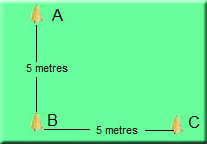

The 'L' Test
Testing and measurement collect information on which subsequent performance evaluations and decisions are made. In the analysis, we need to consider the factors influencing the results.
Objective
To monitor the development of the athlete's speed with directional change. The 'L' Test is also known as the "3 Cone Test".
Required Resources
To conduct this test, you will require:
- Flat non-slip surface.
- Three cones.
- Stopwatch.
- Assistant.
How to conduct the test
This test requires the athlete to touch a series of cones set out in an “L” shape as fast as possible. When required to touch a cone, the athlete can do so with either foot.
- The athlete warms up for 10 minutes.
- The assistant places three cones (A, B, C) as in the diagram below to form an "L" shape where the distance from cone A to cone B is 5 metres and the distance from cone B to cone C is 5 metres. Cone A is the start and finish of the test.
- The athlete stands at cone A facing cone B.
- The assistant gives the signal to 'Go', starts the stopwatch, and the athlete commences the test.
- The athlete runs to and touches cone B, turns and runs back to and touches cone A.
- The athlete turns and runs to and around cone B, keeping it to the left side of the body, to cone C and touches it.
- The athlete turns and runs to and around cone B, keeping it to the right side of the body to cone A.
- The coach stops the stopwatch and records the time the athlete completes the course by passing cone A.

Analysis
Analysis of the result is by comparing it with previous tests' results. It is expected that, with appropriate training between each test, the analysis would indicate an improvement in the athlete's speed.
Target Group
This test is suitable for active athletes where the activity includes directional change while playing (e.g. football, hockey, rugby) but not for individuals where the test would be contraindicated.
Reliability
Test reliability refers to how a test is consistent and stable in measuring its intended measure. Reliability will depend upon how strictly the test is conducted and the individual's level of motivation to perform the test. The following link provides various factors influencing the results and test reliability.
Validity
Test validity refers to the degree to which the test measures what it claims to measure and the extent to which inferences, conclusions, and decisions made based on test scores are appropriate and meaningful. This test provides a means to monitor training on the athlete's physical development.
Advantages
- Minimal equipment is required.
- Simple to set up and conduct.
- Can be conducted almost anywhere.
Disadvantages
- An assistant is required to administer the test.
Page Reference
If you quote information from this page in your work, then the reference for this page is:
- MACKENZIE, B. (2012) 'L' Test [WWW] Available from: https://www.brianmac.co.uk/ltest.htm [Accessed